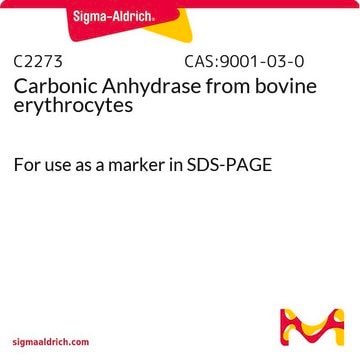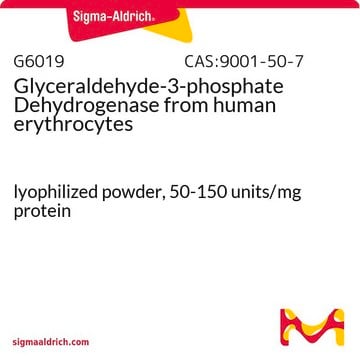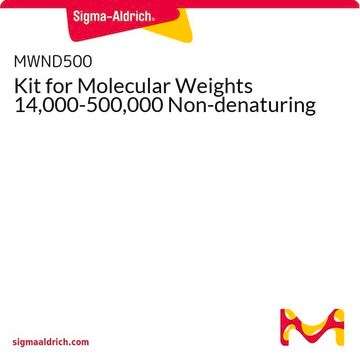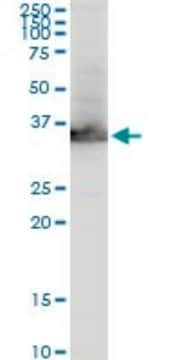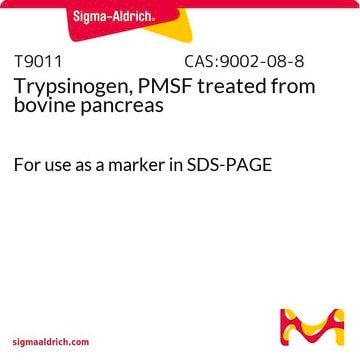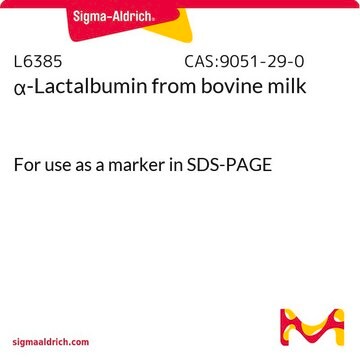G5262
Glycéraldéhyde-3-phosphate déshydrogénase from rabbit muscle
standard for protein electrophoresis
Synonyme(s) :
D-Glycéraldéhyde 3-phosphate:NAD+ oxydoréductase (phosphorylante), GAPDH
Se connecterpour consulter vos tarifs contractuels et ceux de votre entreprise/organisme
About This Item
Produits recommandés
Qualité
for molecular biology
Niveau de qualité
Forme
powder
Poids mol.
~36 kDa
Conditionnement
vial of 5 mg
Technique(s)
electrophoresis: suitable
Température de stockage
2-8°C
Vous recherchez des produits similaires ? Visite Guide de comparaison des produits
Description générale
GAPDH (Glyceraldehyde-3-phosphate dehydrogenase) catalyzes the conversion of glyceraldehyde-3-phosphate into D-glycerate-1,3-bisphosphate as part of the glycolysis pathway. GAPDH has also been found to function in additional cellular process, such as transcription, apoptosis, oxidative stress and ER to Golgi transport.
Application
GAPDH protein is suitable for use as a molecular weight marker and protein standard for molecular biology applications, including western blotting and mass spectometry.
Actions biochimiques/physiologiques
La glycéraldéhyde-3-phosphate déshydrogénase catalyse la conversion du glycéraldéhyde-3-phosphate en D-glycérate-1,3-bisphosphate dans le cadre de la voie de la glycolyse.
Produit(s) apparenté(s)
Réf. du produit
Description
Tarif
Code de la classe de stockage
11 - Combustible Solids
Classe de danger pour l'eau (WGK)
WGK 3
Point d'éclair (°F)
Not applicable
Point d'éclair (°C)
Not applicable
Équipement de protection individuelle
Eyeshields, Gloves, type N95 (US)
Faites votre choix parmi les versions les plus récentes :
Déjà en possession de ce produit ?
Retrouvez la documentation relative aux produits que vous avez récemment achetés dans la Bibliothèque de documents.
Les clients ont également consulté
Ling Ji et al.
Molecular therapy. Nucleic acids, 19, 546-561 (2020-01-14)
Long non-coding RNAs (lncRNAs) are crucial molecules in tumorigenesis and tumor growth in various human cancers, including colorectal cancer (CRC). Studies have revealed that lncRNAs can regulate cellular processes in cancers by interacting with proteins, for example RNA-binding proteins (RBPs).
Kati Juuti-Uusitalo et al.
Investigative ophthalmology & visual science, 54(5), 3510-3519 (2013-05-21)
Aquaporins (AQPs), a family of transmembrane water channel proteins, are essential for allowing passive water transport through retinal pigmented epithelial (RPE) cells. Even though human native RPE cells and immortalized human RPEs have been shown to express AQPs, the expression
Craig Nicholls et al.
Proceedings of the National Academy of Sciences of the United States of America, 109(33), 13308-13313 (2012-08-01)
Oxidative stress regulates telomere homeostasis and cellular aging by unclear mechanisms. Glyceraldehyde 3-phosphate dehydrogenase (GAPDH) is a key mediator of many oxidative stress responses, involving GAPDH nuclear translocation and induction of cell death. We report here that GAPDH interacts with
J E Welch et al.
Journal of andrology, 21(2), 328-338 (2000-03-14)
Although the process of glycolysis is highly conserved in eukaryotes, several glycolytic enzymes have unique structural or functional features in spermatogenic cells. We previously identified and characterized the mouse complementary DNA (cDNA) and a gene for 1 of these enzymes
Xiaopeng Wang et al.
Molecular medicine reports, 23(2) (2020-12-11)
Acute progressive hypoxic respiratory failure caused by various predisposing factors is known as acute respiratory distress syndrome (ARDS). Although penehyclidine hydrochloride (PHC), an anticholinergic drug, is widely applied in clinical practice, the specific mechanisms underlying PHC in the treatment of
Notre équipe de scientifiques dispose d'une expérience dans tous les secteurs de la recherche, notamment en sciences de la vie, science des matériaux, synthèse chimique, chromatographie, analyse et dans de nombreux autres domaines..
Contacter notre Service technique



